The Cornell Lab Bird Academy › Discussion Groups › Nature Journaling and Field Sketching › Jump Right in!
-
My first pencildrawing of the yellow bird. I am going to color it with colorpencils. Can't decide wether to go over it with a black pen first. I know that will give the drawing a harder impression than if I dont. And I dont nessecarily want that. On the other hand I will be more in control of the drawing. /Eva

-
Ready for colors. But was it destroyed in the proces? Hmm

-
@Eva <p style="text-align: left;">Now with colors 🙂</p>

-
-
Trying to the get proportions on the beak just right really made me look at the shape of the beak. A detail I wouldn't have thought about while taking a photo. Drawing lets me pick what stands out to me.
-
 Liz didn’t say to paint, only to draw — so that’s exactly what I did. I worked quickly and tried to capture some dimension in B&W.
1. I loved drawing from the photo … it helped see details & proportions more easily.
The feathers individually were challenging - so I just blocked them in - and the basic shape was fairly easy.
2. The little circle around the eye is never seen unless I draw a bird. The nuanced feathers and markings would not be noticed in detail except for drawing. The beak is very different when drawing from photos than seeing on the wing. All those details would slow me down and possibly cause me to ask WHY/purpose (form follows function) questions in my journal.
Liz didn’t say to paint, only to draw — so that’s exactly what I did. I worked quickly and tried to capture some dimension in B&W.
1. I loved drawing from the photo … it helped see details & proportions more easily.
The feathers individually were challenging - so I just blocked them in - and the basic shape was fairly easy.
2. The little circle around the eye is never seen unless I draw a bird. The nuanced feathers and markings would not be noticed in detail except for drawing. The beak is very different when drawing from photos than seeing on the wing. All those details would slow me down and possibly cause me to ask WHY/purpose (form follows function) questions in my journal. -
 Sketched proportions of bird aren’t exactly right & still need fine tuning.
The 3D quality needs work through shading. Too flat looking.
Overall, the bird does feel cohesive though — like it could actually fly. But the bird needs much tweaking and refinement for accuracy.
Ready for next learning steps…
Sketched proportions of bird aren’t exactly right & still need fine tuning.
The 3D quality needs work through shading. Too flat looking.
Overall, the bird does feel cohesive though — like it could actually fly. But the bird needs much tweaking and refinement for accuracy.
Ready for next learning steps…
-
-
1. Drawing the basic shape of the bird was easy, but adding the details of feathers/shading was more difficult. Drawing from the photo was much easier than drawing in person, since the bird doesn't move or leave. But it was difficult to make the bird look "alive" since it's so static in the photo. 2. I wouldn't have noticed the minor color differences or how the talons curled around the branch without the photo. I would have been too focused on trying to draw the shape and get the base colors for the bird before it left. With creatures, I would have to draw quickly to catch them, which may leave me without the chance to study them closely. With plants and landscapes I should be able to slow down and get the minor details.

-
I'm usually more comfortable drawing from a photo than from real life or memory, probably because the photo allows me lots of time and something 2-D to work from. I only saw all of the beautiful coloured birds posted by others after I had finished mine (and my son his). My 11-year-old son thinks that drawing is more fun than photography and can be more impressive.


-
when you love to draw and enjoy it, all the sensations are really satisfactory and gratifying, was not exactly dificult because usually i make drawings taking a photo as reference, but using few colours with pencils, ballpens and maker pens, so with this course, i hope to learn and test new techniques and materials as watercolor and improve it, more specific i think to emphasize some details in a few brushstrokes, influencing of course, in a more sensitive final result too.

-
1. It felt intimidating in one sense to try to draw that beautiful bird from such an expert photo. What came easily was the basic bird shape inside the brain already but trying to actually translate what was being seen in the photo to the paper was challenging. The finer details of the feather lines and the fluffy feathers along the tops of the legs and the exact sillouette was challenging. 2. Yes, I would not have noticed the finer details of the feather lines and the fluffy feathers along the tops of the legs and the exact sillouette if I had not been asked to draw it. Yes, it will make a difference in nature journaling, to take something that you observe and notice and ensure you capture it in the journal (but it would not have to be excat replication, you could add a note about what that part of your drawing was meant to show).
-
 I got very happily involved in this activity! I can get really precious with my drawings and overwork them, and was stymied at first putting down the first few marks & reworking proportions. I work from photos I've taken frequently because I draw slowly. When out hiking, I usually just take a few notes & then photograph or do a scribbly minimal sketch. Here I decided to play with a mix of pen, watercolor pencil and brush, and pencil. Messing about with media where I'm less comfortable ended up being really satisfying. I know I didn't get the feathers as exact as a photograph, but I don't mind--as long as the significant markers are accurately depicted. (Plus I'm not sure I would ever have the patience.) I did like thinking through how to create an impression of the different textures of the feathers and lichens/mosses and how they moved. Without the photo I certainly wouldn't have picked up on the depth of detail. I do find that I remember more about my observations when I draw and write.
I got very happily involved in this activity! I can get really precious with my drawings and overwork them, and was stymied at first putting down the first few marks & reworking proportions. I work from photos I've taken frequently because I draw slowly. When out hiking, I usually just take a few notes & then photograph or do a scribbly minimal sketch. Here I decided to play with a mix of pen, watercolor pencil and brush, and pencil. Messing about with media where I'm less comfortable ended up being really satisfying. I know I didn't get the feathers as exact as a photograph, but I don't mind--as long as the significant markers are accurately depicted. (Plus I'm not sure I would ever have the patience.) I did like thinking through how to create an impression of the different textures of the feathers and lichens/mosses and how they moved. Without the photo I certainly wouldn't have picked up on the depth of detail. I do find that I remember more about my observations when I draw and write. -
When I draw the birds I feel like I remember them better. I. Enjoy the drawing....but wish I was better at it! Promotion is tough....and the legs and feet are impossible haha!
-
1)I liked drawing from the photo because the bird didn’t fly away or flit around…no wind, lol. Trying to get correct proportions and angles was difficult. I found that I was able to see more detail in the beginning then tapered off toward the end of drawing. 2)I may not have noticed the texture of the birds feathers. The details like the lichen on the branches and the length of the claws help make the drawing realistic.
-
-
 I felt ok drawing from the photo. I've done that many times before. I'm not sure if I've drawn a bird before, though! What I do know is that I didn't get the proportions where I wanted them to be, but I didn't spend much time on this. Still, I feel that if I was drawing out in the field, I would have spent even less time on it.
Getting the colors where I wanted them to be was fairly easy. What was difficult was determining what details I wanted to keep in. It's difficult to get the fine striping on the wings done with the brush I had (the water brush that came with the Koi field watercolor set).
This really got me thinking about the different types of feathers and textures on a bird. Is this important in nature journaling? Maybe, and I suppose that depends on the purpose of the journaling.
Photos have advantages over drawings in that they can show the different textures very well. Being able to show different textures in drawing or painting media takes practice. Pictures can also be created in an instant. However, drawings can show more depth. They can also represent what colors you see in the field; sometimes cameras can be very finicky and they won't pick up on the colors you actually see.
I felt ok drawing from the photo. I've done that many times before. I'm not sure if I've drawn a bird before, though! What I do know is that I didn't get the proportions where I wanted them to be, but I didn't spend much time on this. Still, I feel that if I was drawing out in the field, I would have spent even less time on it.
Getting the colors where I wanted them to be was fairly easy. What was difficult was determining what details I wanted to keep in. It's difficult to get the fine striping on the wings done with the brush I had (the water brush that came with the Koi field watercolor set).
This really got me thinking about the different types of feathers and textures on a bird. Is this important in nature journaling? Maybe, and I suppose that depends on the purpose of the journaling.
Photos have advantages over drawings in that they can show the different textures very well. Being able to show different textures in drawing or painting media takes practice. Pictures can also be created in an instant. However, drawings can show more depth. They can also represent what colors you see in the field; sometimes cameras can be very finicky and they won't pick up on the colors you actually see. -
1: I felt nervous as I have never felt I had any talent for art. This is my first ever attempt at drawing a bird. Getting the general shape was fairly easy. Getting the color right and drawing the beak was challenging. 2: The Lichen on the tree branch, two types I think. Also the fine brown striping on the breast of the warbler was more obvious when I was trying to draw it. When nature journaling I will need to train myself to be more observant of details.

-
I found it hard to make a bird look like it has feathers. I also found that I'd like to get a finer tipped paintbrush to allow for better details. I was surprised that I could get the texture of the leaves I wanted just from a quick sketch and going over it with a pen.

-
 I felt a bit stressed about starting. Then I just went ahead and drew using a pencil. I’d like to wait for instructions before I start painting. My critique was easier and had better flow than my drawing. I’d like to even that out as I get better. The most interesting thing I noticed was that I thought the bird was facing me so that I got the right and left legs mixed up. That is one point for drawing over just taking a photo - analyzing what you see. Probably the best advantage of the photo - you’ve got it before the bird takes off.
I felt a bit stressed about starting. Then I just went ahead and drew using a pencil. I’d like to wait for instructions before I start painting. My critique was easier and had better flow than my drawing. I’d like to even that out as I get better. The most interesting thing I noticed was that I thought the bird was facing me so that I got the right and left legs mixed up. That is one point for drawing over just taking a photo - analyzing what you see. Probably the best advantage of the photo - you’ve got it before the bird takes off. -
 I started with a light pencil outline, then added color with watercolor pencils, with which I have no experience. Not especially satisfied with the color from these pencils, so I'd like to try watercolor paint next time. I like working from photos because in the wild you usually get only a quick glimpse of a bird. They don't stand still for long (except Great Blue Herons, who will stand motionless for hours).
I started with a light pencil outline, then added color with watercolor pencils, with which I have no experience. Not especially satisfied with the color from these pencils, so I'd like to try watercolor paint next time. I like working from photos because in the wild you usually get only a quick glimpse of a bird. They don't stand still for long (except Great Blue Herons, who will stand motionless for hours). -
I usually draw from photo for inspiration but not for exact likeness, close but not exact. I want to get better at drawing live examples . Might still take photo for color reference and the patterns on subject till I get better at drawing from live forms. Hoping to sharpen drawing skills from live nature forms first then develop better water color painting and notes and super simple color. I am not fast at drawing from live objects so this is going to be a challenge for me, but I look forward to it. Joan Stanton
-
 Well , here is my first horrible attempt with pure water color. I normally paint with gouache or water color pencil. Hoping to learn more techniques from this course. Joan Stanton
Well , here is my first horrible attempt with pure water color. I normally paint with gouache or water color pencil. Hoping to learn more techniques from this course. Joan Stanton
-
It was fun to not think or add judgement to my first drawing - I'm new so it can be bad. It didn't end up looking terrible and I found that when I took the pressure off I also focused more on what the bird was perched on. I missed the moss and lichen but adding the leaves made the whole experience for me. Lil yellow came out looking as happy as I am right now!

-
Drawing is something out of my comfort zone, but hope to improve upon during this course. It was good to be able to refer back to the photo when I was drawing. The branches and leaves were somewhat easy to draw. But getting the proportions of all items in the photo was a bit challenging along with drawing the warbler's head. My drawing is not ready for prime time showing....maybe next time.
-

-
I enjoyed drawing the picture. It is certainly apparent that drawing it really make me notice lots of details.

-
I found this sketch very difficult (challenging?), especially getting the proper proportions and placement of the bill and eye. Obviously, I still have a lot to learn about drawing feet. The textures and colors of the branch, and particularly the lichen, were a challenge.
 The bill is one of the key features distinguishing warblers, so I struggled to get the size and shape of the bill right. I'd draw it too large, then erase it and draw it again but this time too short, then again too large, then again too short. I drew 5 or 6 iterations of the bill and I'm still not sure it's correct.
This is my first attempt at seriously using colored pencils. I found it both satisfying and frustrating. It was satisfying to be able to add a bit of color to my sketch and it was easy to control where the color went, but it was frustrating in that all the colors appeared very pale and lacked vibrancy. I used colored pencils that I had on hand from a prior effort with "adult coloring books" and I was frustrated by my limited palette and inability to blend colors.
I look forward to learning to use and mix watercolors and hopefully get more vibrant colors and a wider range of shades and hues.
The bill is one of the key features distinguishing warblers, so I struggled to get the size and shape of the bill right. I'd draw it too large, then erase it and draw it again but this time too short, then again too large, then again too short. I drew 5 or 6 iterations of the bill and I'm still not sure it's correct.
This is my first attempt at seriously using colored pencils. I found it both satisfying and frustrating. It was satisfying to be able to add a bit of color to my sketch and it was easy to control where the color went, but it was frustrating in that all the colors appeared very pale and lacked vibrancy. I used colored pencils that I had on hand from a prior effort with "adult coloring books" and I was frustrated by my limited palette and inability to blend colors.
I look forward to learning to use and mix watercolors and hopefully get more vibrant colors and a wider range of shades and hues. -
1. I was, at first, afraid...anxious. I wanted to do well, but I was afraid of creating something terrible here at the beginning. Patience came easily once I started drawing. Attention and forgetting time are natural to me. Getting the angles and attitudes correct was challenging. My warbler's head is still a bit too tall. Maybe more round than oval? Getting the forward-lean sleekness of the bird was difficult. 2. I definitely noticed new things like the moss at the base of the branch junction the bird is perched on. This and the bites out of many of the leaves (insect bites, I assume?) were things I didn't see until I attempted to draw them. Also, the knobbiness of the branch, the light and dark sides of individual leaves, the amount of black in the bird's tail feathers...all of these were details I didn't see in this picture until I attempted to draw the picture. For a difference this would make, I think this level of detail would help my ability to identify similar birds. Also, even more than simply identification, the appreciation of a bird's (or a branches) beauty grows with the attention I dedicate to it. I've noticed this with the birds that regularly return to my feeder. I never realized how formal and sleek chickadees were until I observed their tail feather patterns day by day. Similarly, the intensity of a red breasted nuthatch when it fights alone for its spot on the feeder formerly occupied by four chickadees than pauses curling it's body out to stare down any potential combatants.
 I also included my 9-year-old son's drawing. He saw what I was doing and asked to sit and join me. I've wanted to get both my boys more into birding as I fall more in love with it, and this was a great step in that direction. For him:
1. It looked pretty hard, but everything was actually easier than I thought.
2. Probably the details on the leaves and how there were more than one in some places that I thought was just one big one. Now I know that some hard drawings you have to look at pictures and you could get pretty good at it.
I also included my 9-year-old son's drawing. He saw what I was doing and asked to sit and join me. I've wanted to get both my boys more into birding as I fall more in love with it, and this was a great step in that direction. For him:
1. It looked pretty hard, but everything was actually easier than I thought.
2. Probably the details on the leaves and how there were more than one in some places that I thought was just one big one. Now I know that some hard drawings you have to look at pictures and you could get pretty good at it.

-

-
 I enjoyed interpreting the little textures and values of the lichen and moss on the branch. Drawing allows you to remember things more vividly than a photograph does.
I enjoyed interpreting the little textures and values of the lichen and moss on the branch. Drawing allows you to remember things more vividly than a photograph does.
Read More:

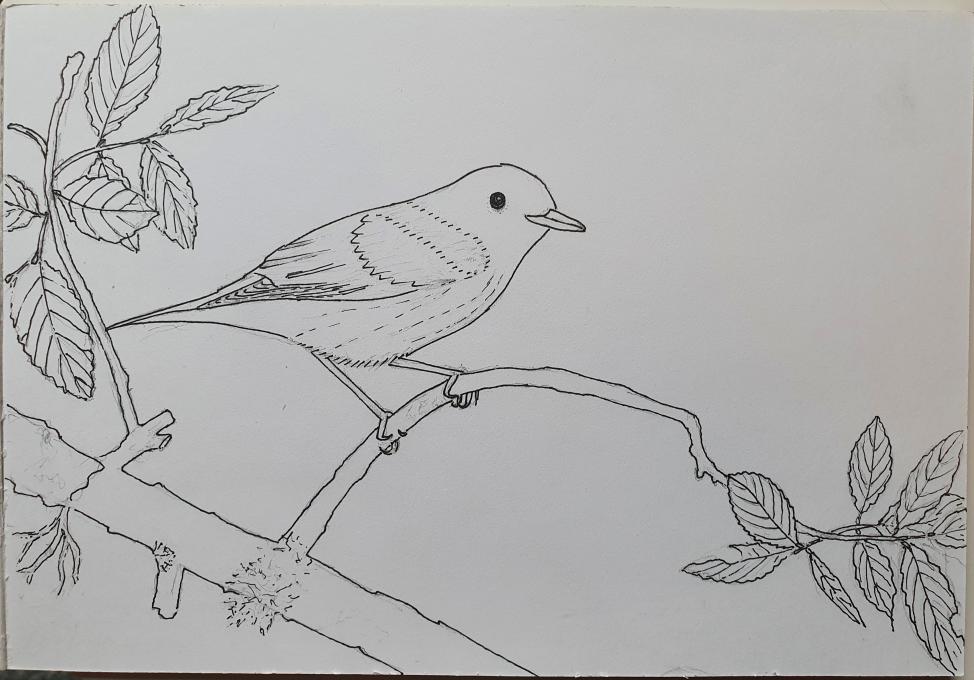

 Liz didn’t say to paint, only to draw — so that’s exactly what I did. I worked quickly and tried to capture some dimension in B&W.
1. I loved drawing from the photo … it helped see details & proportions more easily.
The feathers individually were challenging - so I just blocked them in - and the basic shape was fairly easy.
2. The little circle around the eye is never seen unless I draw a bird. The nuanced feathers and markings would not be noticed in detail except for drawing. The beak is very different when drawing from photos than seeing on the wing. All those details would slow me down and possibly cause me to ask WHY/purpose (form follows function) questions in my journal.
Liz didn’t say to paint, only to draw — so that’s exactly what I did. I worked quickly and tried to capture some dimension in B&W.
1. I loved drawing from the photo … it helped see details & proportions more easily.
The feathers individually were challenging - so I just blocked them in - and the basic shape was fairly easy.
2. The little circle around the eye is never seen unless I draw a bird. The nuanced feathers and markings would not be noticed in detail except for drawing. The beak is very different when drawing from photos than seeing on the wing. All those details would slow me down and possibly cause me to ask WHY/purpose (form follows function) questions in my journal. 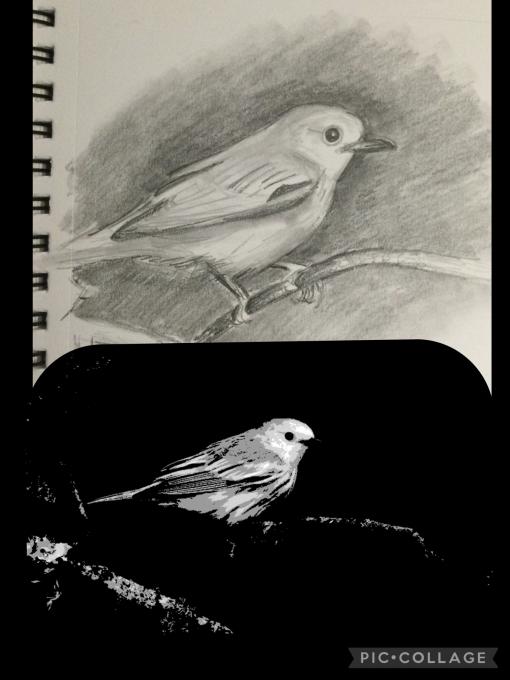 Sketched proportions of bird aren’t exactly right & still need fine tuning.
The 3D quality needs work through shading. Too flat looking.
Overall, the bird does feel cohesive though — like it could actually fly. But the bird needs much tweaking and refinement for accuracy.
Ready for next learning steps…
Sketched proportions of bird aren’t exactly right & still need fine tuning.
The 3D quality needs work through shading. Too flat looking.
Overall, the bird does feel cohesive though — like it could actually fly. But the bird needs much tweaking and refinement for accuracy.
Ready for next learning steps…
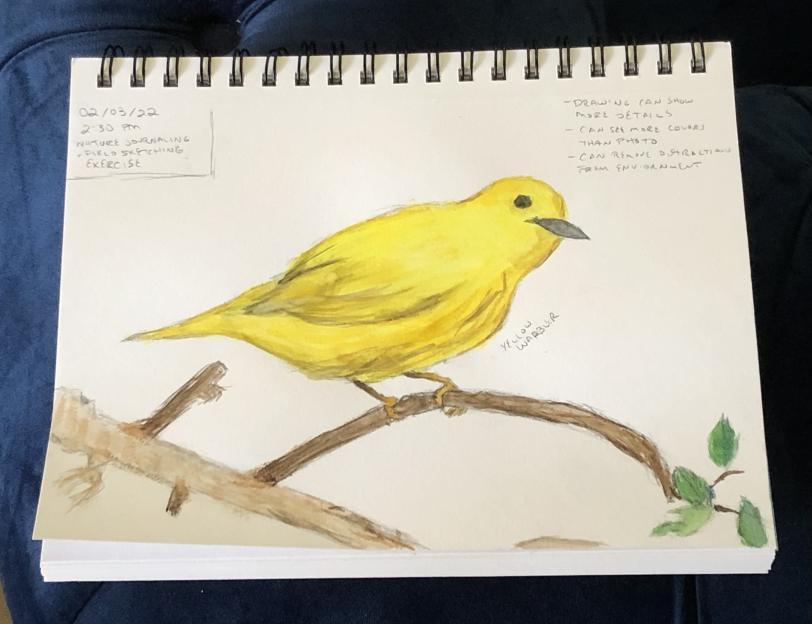
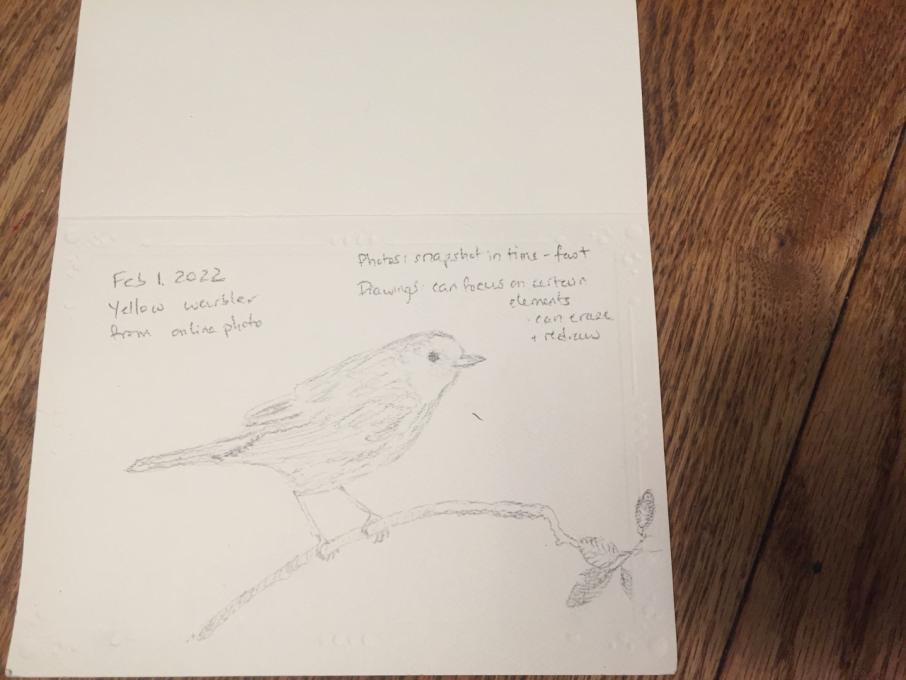
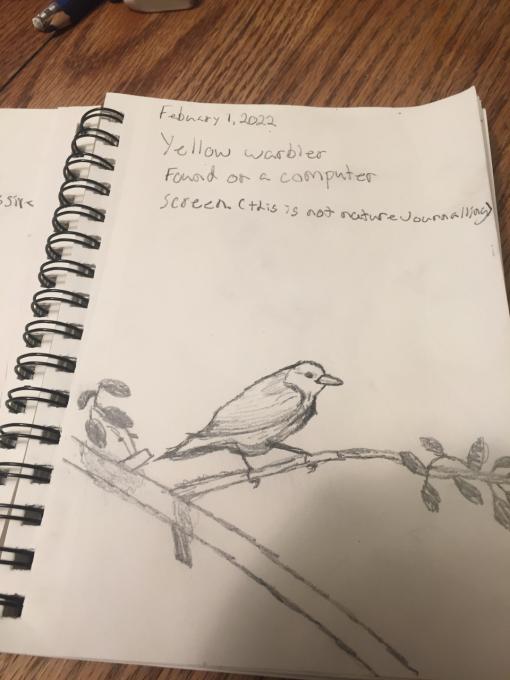
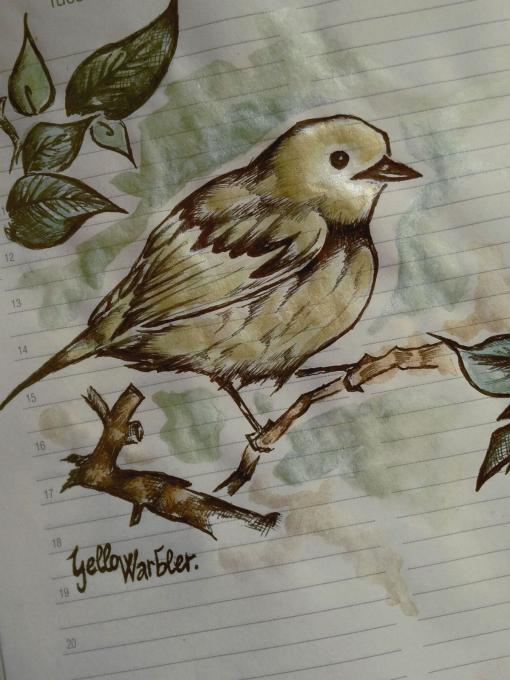
 I got very happily involved in this activity! I can get really precious with my drawings and overwork them, and was stymied at first putting down the first few marks & reworking proportions. I work from photos I've taken frequently because I draw slowly. When out hiking, I usually just take a few notes & then photograph or do a scribbly minimal sketch. Here I decided to play with a mix of pen, watercolor pencil and brush, and pencil. Messing about with media where I'm less comfortable ended up being really satisfying. I know I didn't get the feathers as exact as a photograph, but I don't mind--as long as the significant markers are accurately depicted. (Plus I'm not sure I would ever have the patience.) I did like thinking through how to create an impression of the different textures of the feathers and lichens/mosses and how they moved. Without the photo I certainly wouldn't have picked up on the depth of detail. I do find that I remember more about my observations when I draw and write.
I got very happily involved in this activity! I can get really precious with my drawings and overwork them, and was stymied at first putting down the first few marks & reworking proportions. I work from photos I've taken frequently because I draw slowly. When out hiking, I usually just take a few notes & then photograph or do a scribbly minimal sketch. Here I decided to play with a mix of pen, watercolor pencil and brush, and pencil. Messing about with media where I'm less comfortable ended up being really satisfying. I know I didn't get the feathers as exact as a photograph, but I don't mind--as long as the significant markers are accurately depicted. (Plus I'm not sure I would ever have the patience.) I did like thinking through how to create an impression of the different textures of the feathers and lichens/mosses and how they moved. Without the photo I certainly wouldn't have picked up on the depth of detail. I do find that I remember more about my observations when I draw and write. 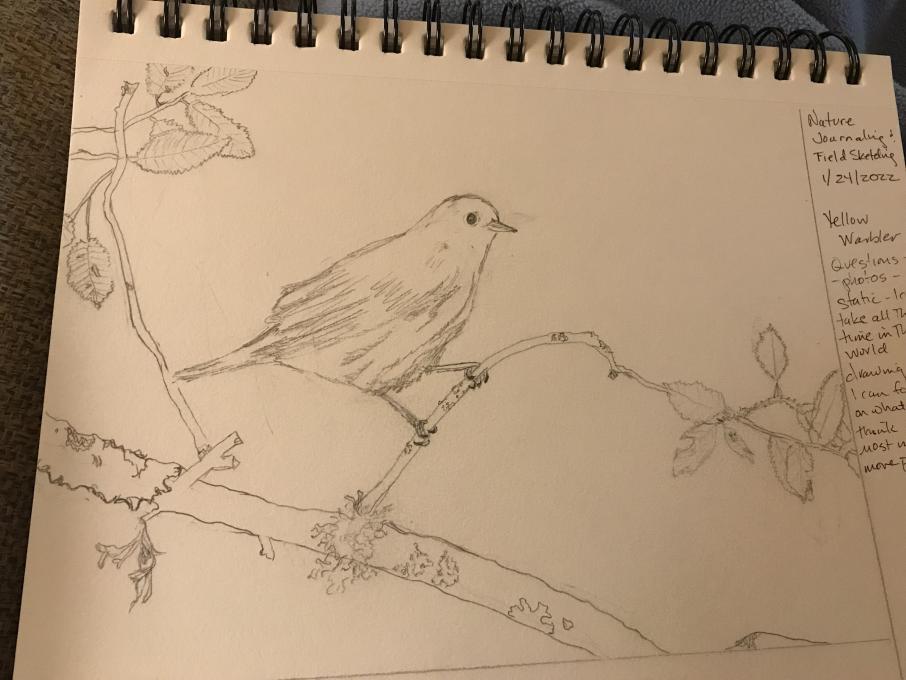
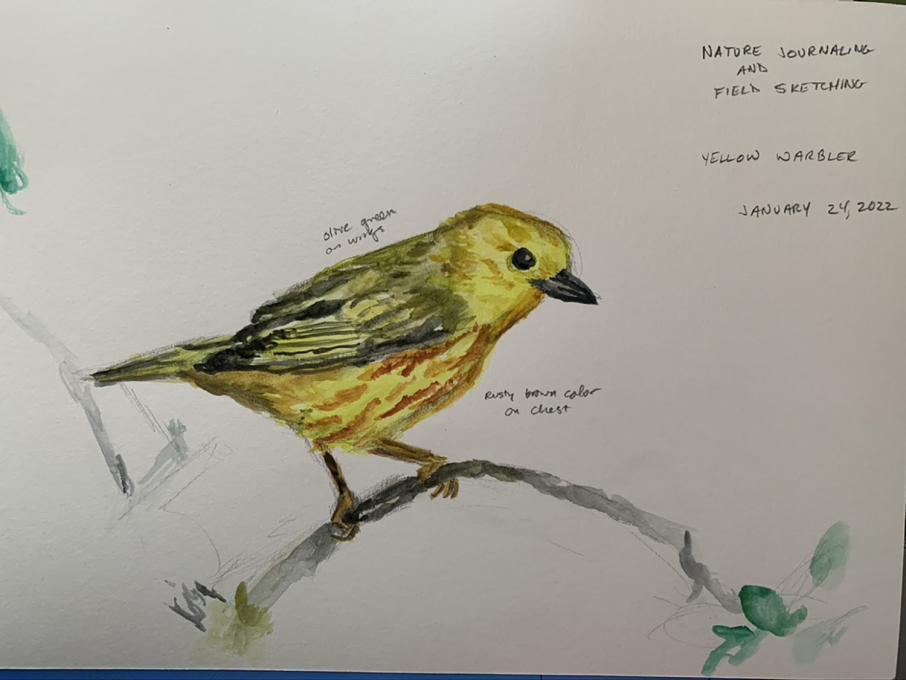 I felt ok drawing from the photo. I've done that many times before. I'm not sure if I've drawn a bird before, though! What I do know is that I didn't get the proportions where I wanted them to be, but I didn't spend much time on this. Still, I feel that if I was drawing out in the field, I would have spent even less time on it.
Getting the colors where I wanted them to be was fairly easy. What was difficult was determining what details I wanted to keep in. It's difficult to get the fine striping on the wings done with the brush I had (the water brush that came with the Koi field watercolor set).
This really got me thinking about the different types of feathers and textures on a bird. Is this important in nature journaling? Maybe, and I suppose that depends on the purpose of the journaling.
Photos have advantages over drawings in that they can show the different textures very well. Being able to show different textures in drawing or painting media takes practice. Pictures can also be created in an instant. However, drawings can show more depth. They can also represent what colors you see in the field; sometimes cameras can be very finicky and they won't pick up on the colors you actually see.
I felt ok drawing from the photo. I've done that many times before. I'm not sure if I've drawn a bird before, though! What I do know is that I didn't get the proportions where I wanted them to be, but I didn't spend much time on this. Still, I feel that if I was drawing out in the field, I would have spent even less time on it.
Getting the colors where I wanted them to be was fairly easy. What was difficult was determining what details I wanted to keep in. It's difficult to get the fine striping on the wings done with the brush I had (the water brush that came with the Koi field watercolor set).
This really got me thinking about the different types of feathers and textures on a bird. Is this important in nature journaling? Maybe, and I suppose that depends on the purpose of the journaling.
Photos have advantages over drawings in that they can show the different textures very well. Being able to show different textures in drawing or painting media takes practice. Pictures can also be created in an instant. However, drawings can show more depth. They can also represent what colors you see in the field; sometimes cameras can be very finicky and they won't pick up on the colors you actually see. 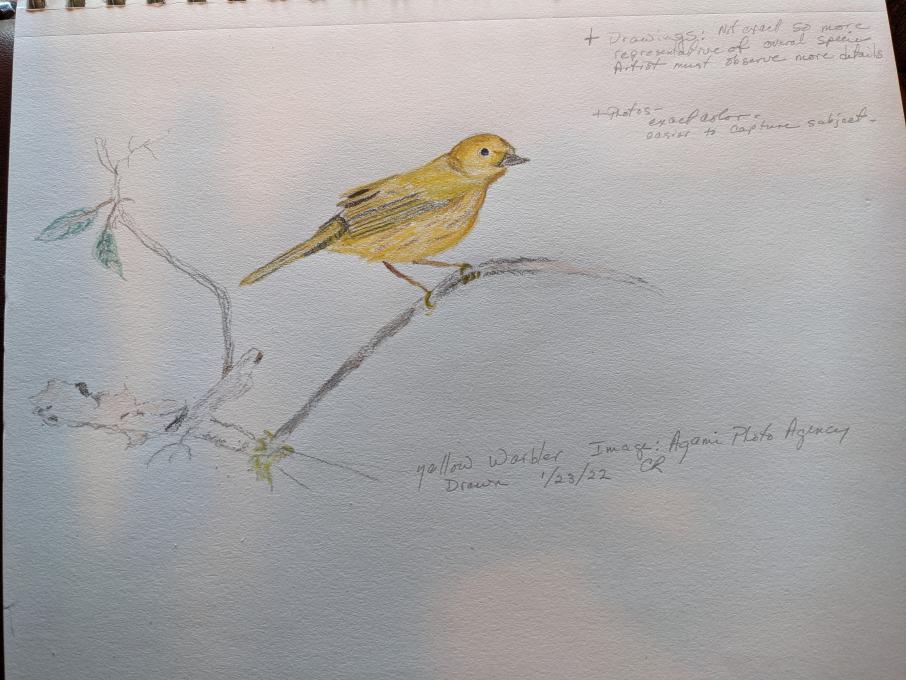

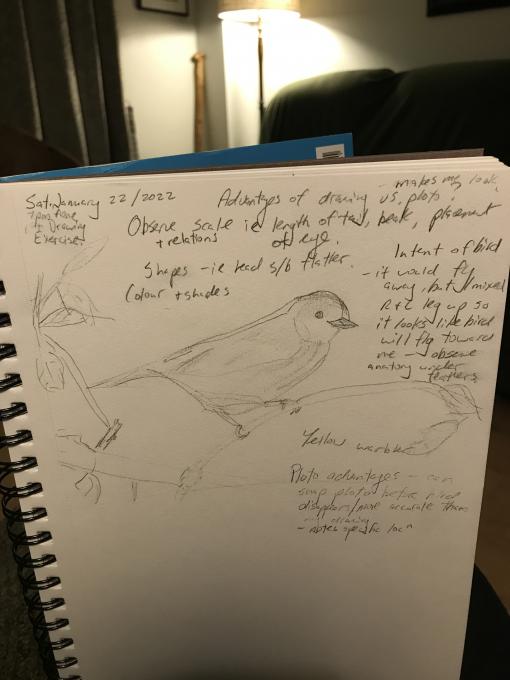 I felt a bit stressed about starting. Then I just went ahead and drew using a pencil. I’d like to wait for instructions before I start painting. My critique was easier and had better flow than my drawing. I’d like to even that out as I get better. The most interesting thing I noticed was that I thought the bird was facing me so that I got the right and left legs mixed up. That is one point for drawing over just taking a photo - analyzing what you see. Probably the best advantage of the photo - you’ve got it before the bird takes off.
I felt a bit stressed about starting. Then I just went ahead and drew using a pencil. I’d like to wait for instructions before I start painting. My critique was easier and had better flow than my drawing. I’d like to even that out as I get better. The most interesting thing I noticed was that I thought the bird was facing me so that I got the right and left legs mixed up. That is one point for drawing over just taking a photo - analyzing what you see. Probably the best advantage of the photo - you’ve got it before the bird takes off. 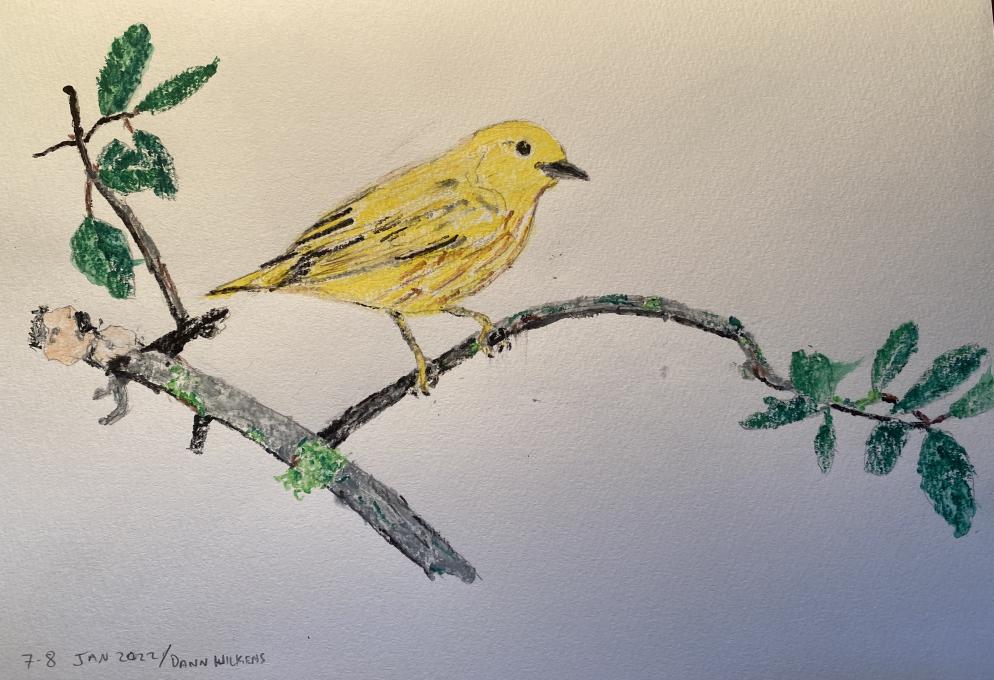 I started with a light pencil outline, then added color with watercolor pencils, with which I have no experience. Not especially satisfied with the color from these pencils, so I'd like to try watercolor paint next time. I like working from photos because in the wild you usually get only a quick glimpse of a bird. They don't stand still for long (except Great Blue Herons, who will stand motionless for hours).
I started with a light pencil outline, then added color with watercolor pencils, with which I have no experience. Not especially satisfied with the color from these pencils, so I'd like to try watercolor paint next time. I like working from photos because in the wild you usually get only a quick glimpse of a bird. They don't stand still for long (except Great Blue Herons, who will stand motionless for hours). 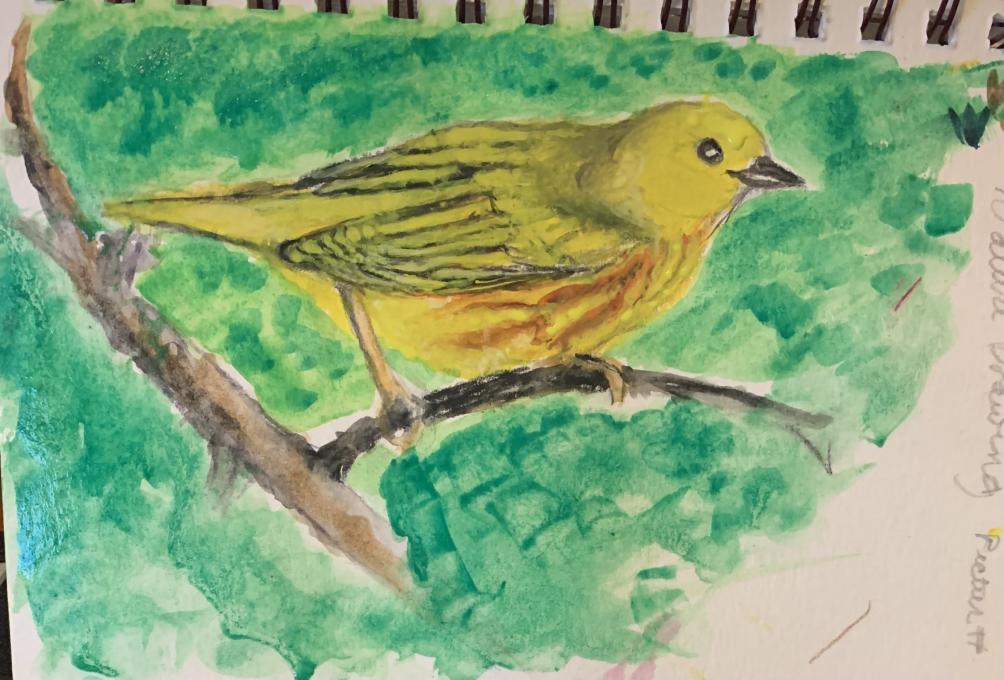 Well , here is my first horrible attempt with pure water color. I normally paint with gouache or water color pencil. Hoping to learn more techniques from this course. Joan Stanton
Well , here is my first horrible attempt with pure water color. I normally paint with gouache or water color pencil. Hoping to learn more techniques from this course. Joan Stanton
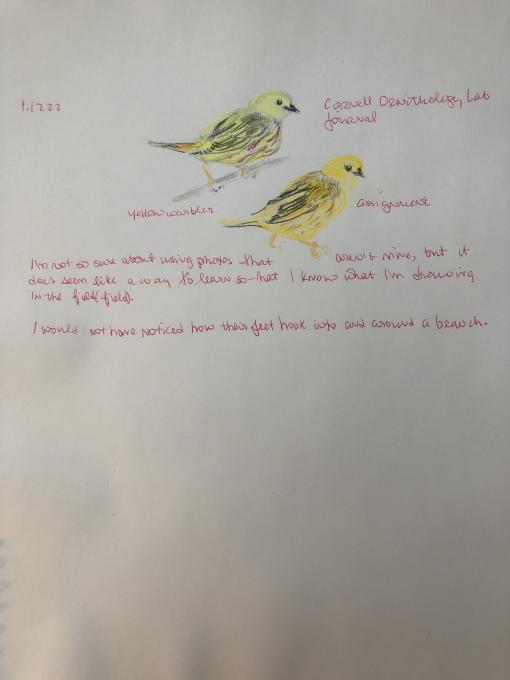

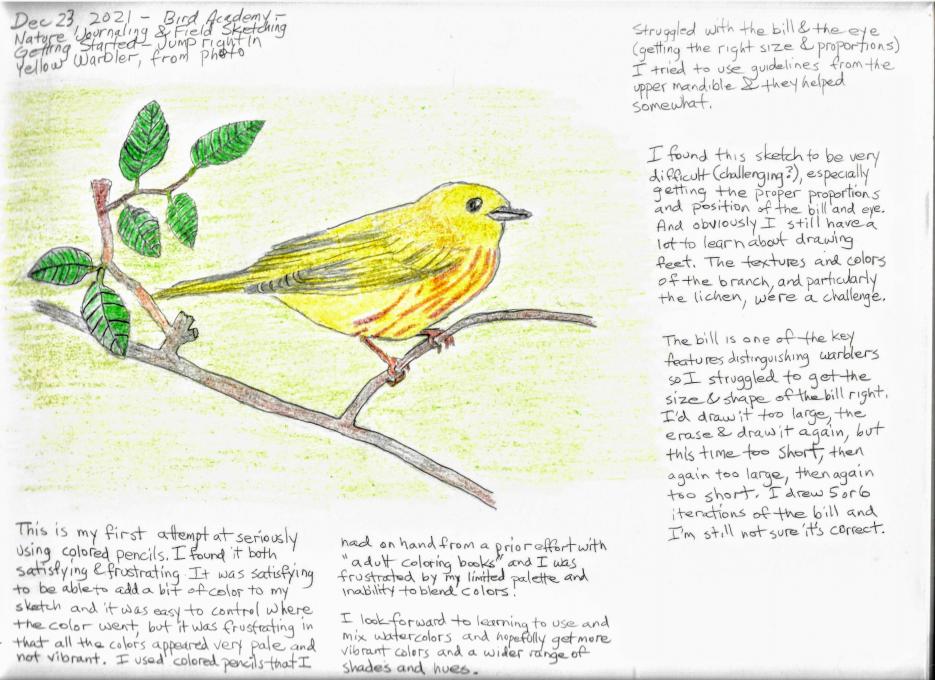 The bill is one of the key features distinguishing warblers, so I struggled to get the size and shape of the bill right. I'd draw it too large, then erase it and draw it again but this time too short, then again too large, then again too short. I drew 5 or 6 iterations of the bill and I'm still not sure it's correct.
This is my first attempt at seriously using colored pencils. I found it both satisfying and frustrating. It was satisfying to be able to add a bit of color to my sketch and it was easy to control where the color went, but it was frustrating in that all the colors appeared very pale and lacked vibrancy. I used colored pencils that I had on hand from a prior effort with "adult coloring books" and I was frustrated by my limited palette and inability to blend colors.
I look forward to learning to use and mix watercolors and hopefully get more vibrant colors and a wider range of shades and hues.
The bill is one of the key features distinguishing warblers, so I struggled to get the size and shape of the bill right. I'd draw it too large, then erase it and draw it again but this time too short, then again too large, then again too short. I drew 5 or 6 iterations of the bill and I'm still not sure it's correct.
This is my first attempt at seriously using colored pencils. I found it both satisfying and frustrating. It was satisfying to be able to add a bit of color to my sketch and it was easy to control where the color went, but it was frustrating in that all the colors appeared very pale and lacked vibrancy. I used colored pencils that I had on hand from a prior effort with "adult coloring books" and I was frustrated by my limited palette and inability to blend colors.
I look forward to learning to use and mix watercolors and hopefully get more vibrant colors and a wider range of shades and hues.  I also included my 9-year-old son's drawing. He saw what I was doing and asked to sit and join me. I've wanted to get both my boys more into birding as I fall more in love with it, and this was a great step in that direction. For him:
1. It looked pretty hard, but everything was actually easier than I thought.
2. Probably the details on the leaves and how there were more than one in some places that I thought was just one big one. Now I know that some hard drawings you have to look at pictures and you could get pretty good at it.
I also included my 9-year-old son's drawing. He saw what I was doing and asked to sit and join me. I've wanted to get both my boys more into birding as I fall more in love with it, and this was a great step in that direction. For him:
1. It looked pretty hard, but everything was actually easier than I thought.
2. Probably the details on the leaves and how there were more than one in some places that I thought was just one big one. Now I know that some hard drawings you have to look at pictures and you could get pretty good at it.


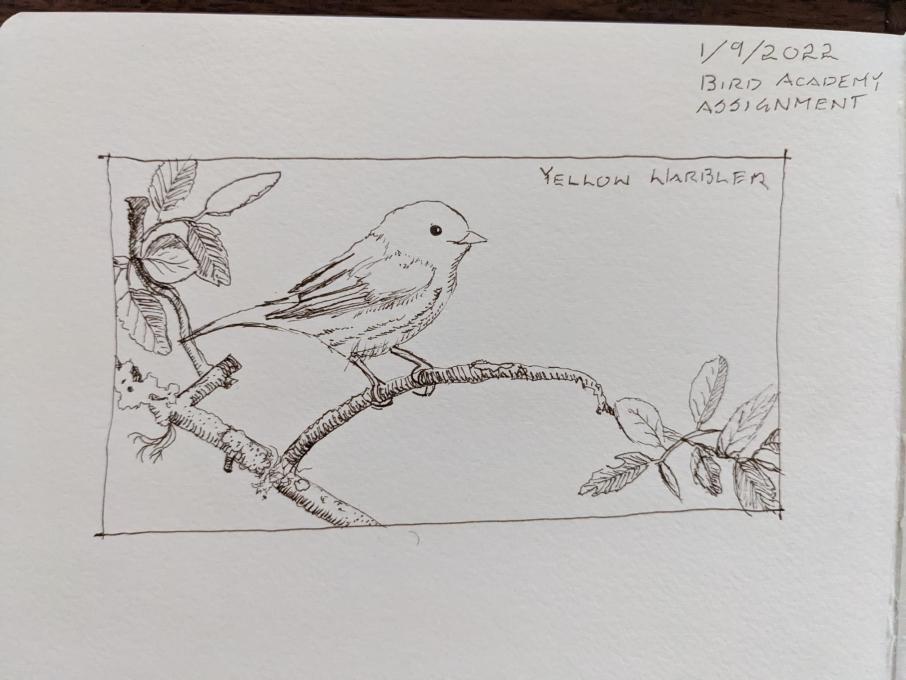 I enjoyed interpreting the little textures and values of the lichen and moss on the branch. Drawing allows you to remember things more vividly than a photograph does.
I enjoyed interpreting the little textures and values of the lichen and moss on the branch. Drawing allows you to remember things more vividly than a photograph does.